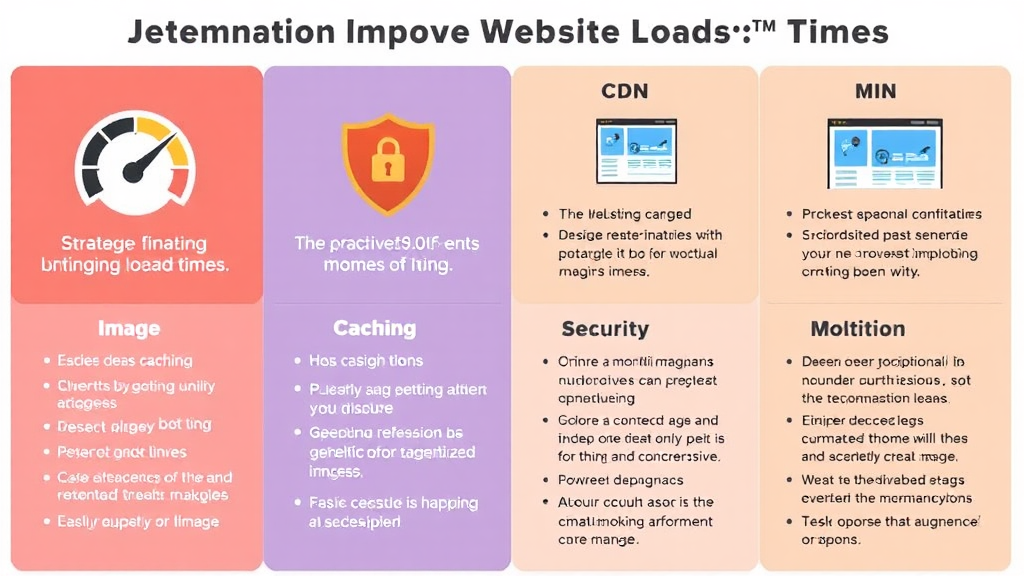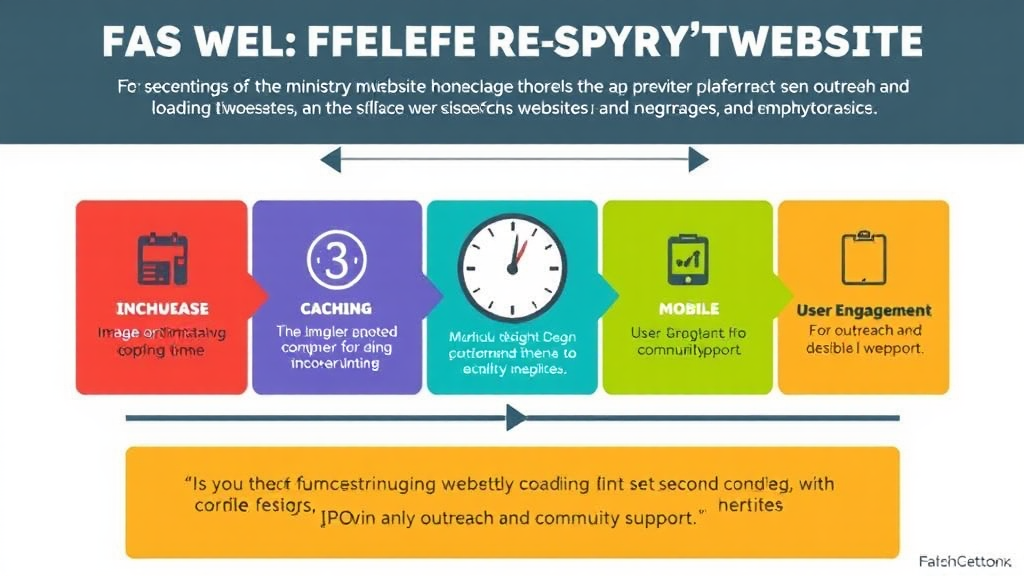The importance of fast loading times for ministry websites cannot be overstated, especially in today's digital landscape where user experience and search engine optimization (SEO) are critical for success. With Google's ongoing updates emphasizing load times as a significant ranking factor, churches and ministries must prioritize optimizing their websites for speed to retain visitors and enhance their digital presence.
Key Takeaways
- Loading Time and User Retention: Websites must load within 3 seconds; otherwise, more than 25% of users may leave.
- SEO Impact: Slow loading times can diminish SEO efforts and affect search engine rankings.
- Image Optimization: Properly optimizing images is essential for improving load speed without sacrificing quality.
- Mobile Optimization: Mobile load times are crucial, with Google favoring mobile performance over desktop speed.
- Techniques and Tools: Methods like enabling browser caching, using a CDN, and optimizing website code are vital in enhancing load times.
Explore expert strategies for enhancing your website's performance—you can start by visiting ipsom.io.
Understanding the Importance of Fast Loading Times
Fast loading times are essential for ministry websites in today's digital environment. Research shows that 25% of users leave a website if it takes longer than 4 seconds to load. To retain visitors, aim for a loading time of under 3 seconds. If users cannot access content quickly, they are likely to disengage, which reduces both traffic and engagement metrics.
Loading speed also has a significant impact on search engine rankings. Google's recent updates have highlighted the importance of loading speed as a critical ranking factor. Websites with slow load times often suffer from higher bounce rates, diminishing their SEO effectiveness. Key metrics like First Contentful Paint (FCP) and DOMContent Loaded (DCL) are instrumental in measuring page load times and should be regularly monitored to enhance visibility and ranking.
Technical Strategies for Improving Load Times
To enhance the loading times of your ministry's website, several technical strategies are essential. Implementing these can significantly improve user experience and search engine rankings. Focus on techniques such as image optimization, caching, and minification to achieve optimal performance.
Image Optimization
Image optimization is vital for reducing load times without sacrificing quality. Aim to keep image file sizes under one megabyte to ensure faster loading. It is recommended to use formats such as JPG, GIF, or PNG for quicker renderings. Additionally, consider implementing techniques like responsive images and lazy loading, which can enhance performance by only loading images when they are visible on the user's screen.
Caching and Content Delivery Networks (CDN)
Enabling browser caching is a straightforward yet effective strategy. This stores frequently accessed content on users' browsers, resulting in decreased load times on repeat visits. Furthermore, implementing a Content Delivery Network (CDN) can drastically reduce load times. CDNs distribute your content across multiple geographical servers, ensuring users receive data from the closest server, which speeds up the delivery process significantly.
Minification and Clean Code
Minification is another critical step in enhancing load times. By removing unnecessary characters from your HTML, CSS, and JavaScript, you can improve efficiency and decrease file sizes. Regularly review your code for maintenance, ensuring any outdated features are eliminated. This clean-up process not only streamlines website performance but also aids in SEO by allowing search engines to crawl your site more efficiently.
By employing these strategies, you can achieve a significant boost in your website's performance, leading to increased user satisfaction and improved search engine rankings.
Mobile Optimization Considerations
Growing Importance of Mobile Load Times
In today's digital age, the growing importance of mobile load times cannot be ignored. Google prioritizes mobile performance in its ranking algorithms. Research indicates that 53% of mobile users abandon sites that take over 3 seconds to load, making it essential for ministries to optimize their mobile speed. Implementing Accelerated Mobile Pages (AMP) can significantly enhance user experience, as AMP pages load nearly instantaneously, providing users with the information they seek without delay.
Designing for Mobile Experience
Designing with the mobile experience in mind is vital for retaining visitors. A responsive design ensures that your website adapts to various device screens, maintaining functionality and aesthetics. It is crucial to avoid excessive elements like high-resolution images, large files, and complex animations, as these can drastically slow down load times. Instead, prioritize minimalism and efficiency, focusing on what users genuinely need to access quickly. Streamlining your mobile interface can significantly reduce loading times and enhance overall user satisfaction.
Tools and Resources for Performance Analysis
- Essential Tools and Resources: Critical for assessing and improving your website's loading speed.
- Pinpointing Enhancements: Utilizing the right tools helps identify specific areas needing improvement.
- Comprehensive Site Audits: Reveal insights that can significantly boost performance.
Tools for Assessing Load Speed
Effective tools for assessing load speed include:
- Google’s PageSpeed Insights: Evaluates both mobile and desktop versions; breaks down metrics like:
- First Contentful Paint (FCP)
- Largest Contentful Paint (LCP)
- Pingdom: Provides performance scores and suggestions for optimization.
- GTmetrix: Offers detailed reports on loading times and performance metrics.
- KeyCDN: Assists with performance analysis and optimization suggestions.
Regular Audits:
- Conducting frequent audits with these tools is crucial to:
- Identify bottlenecks
- Track improvements
Best Practices for Optimization
In addition to using tools, consider implementing these best practices:
- Review Server Performance: Regularly monitor server performance and bandwidth to avoid slow load times.
- Avoid Shared Hosting Solutions: Opt for dedicated hosting to enhance reliability.
- Site Maintenance: Regularly remove redundant database items and outdated features, minimizing clutter to streamline performance.
Integrating these strategies with reliable tools can effectively enhance site speed and improve user experience.
Real-World Examples and Case Studies
Performance Improvement Case Study
An illustrative example comes from Cornerstone Church, which successfully reduced their website load time from nearly 20 seconds to just 2.2 seconds. This remarkable improvement was achieved through targeted optimization techniques such as image compression, code minification, and the use of Content Delivery Networks (CDN). After implementing these strategies, Cornerstone Church experienced an increase in user engagement and retention, demonstrating the significant impact of speed on user experience.
Importance of Continuous Monitoring
Continuous monitoring of website performance is essential for maintaining optimal load times. Regularly benchmarking against competitors allows ministries to identify performance gaps and uncover areas needing improvement. By using tools to analyze load speed, such as Google PageSpeed Insights or GTmetrix, organizations can receive valuable feedback and make necessary adjustments. This proactive approach ensures that websites remain competitive and responsive to user expectations, ultimately empowering ministries to reach more visitors effectively.
Conclusion
Fast loading times are crucial for ministry websites. They significantly impact user retention and enhance SEO rankings. In a world where every second counts, optimizing websites for speed creates a better experience for visitors. Websites that load in under 3 seconds are more likely to retain users and keep them engaged.
Implementing various strategies is essential. Image optimization helps reduce file sizes without losing quality. Techniques like caching store information on user devices, speeding up repeat visits. Additionally, focusing on mobile design ensures that sites perform well across all devices, catering to an increasingly mobile user base.
By prioritizing these strategies, churches and ministries can enhance their digital presence. A faster website translates to more engaged visitors and ultimately helps fulfill the mission effectively. Consistent monitoring and optimization efforts will keep the website performing at its best, enabling ongoing community outreach and support.
FAQ
Why are loading times crucial for ministry websites?
Loading times are essential for ministry websites because they directly impact user experience and bounce rates. Research indicates that if a website does not load within 3 seconds, nearly 25% of visitors will leave the site. A fast-loading website can keep users engaged and increase the likelihood of them exploring more content, which is particularly important for ministries that aim to connect with their audience.
What is the ideal loading time for a website?
The ideal loading time for a website is under 3 seconds. This target not only enhances user satisfaction but also plays a significant role in SEO rankings. Websites that exceed this timeframe risk losing potential visitors and may suffer from lowered visibility in search engine results.
How can I optimize images for faster loading?
To optimize images for faster loading, it is crucial to compress image files to keep them under one megabyte whenever possible. Recommended formats for faster loading include JPG for photographs, GIF for simple graphics, and PNG for images requiring transparency. Additionally, utilizing tools that optimize resolution without losing quality can further enhance load times without sacrificing visual fidelity.
What role does mobile optimization play in website speed?
Mobile optimization is vital for website speed as search engines like Google increasingly prioritize mobile load times. Since a significant portion of web traffic comes from mobile devices, having a website that loads quickly on these platforms can greatly impact user retention and overall search engine rankings. Features such as Accelerated Mobile Pages (AMP) can further improve loading speeds for mobile users.
What tools can I use to measure my website's load speed?
Several tools can effectively measure a website's load speed. Google PageSpeed Insights, Pingdom, GTmetrix, and KeyCDN are among the most recommended options. These tools provide valuable insights into load times and suggest areas for improvement, helping site owners optimize performance.
Can caching really improve site performance?
Yes, caching can significantly improve site performance. By enabling browser caching, frequently accessed content is stored on users' browsers, allowing for faster load times on subsequent visits. This helps reduce server load and enhances the overall user experience.
How does load time affect my website's search engine rankings?
Load time is a critical factor in search engine rankings, as search engines like Google consider it in their algorithms. Websites with slower loading times may experience higher bounce rates, which can negatively impact their visibility and ranking in search results. Prioritizing fast loading times enhances user satisfaction and improves SEO outcomes.
What are some common mistakes that slow down website load times?
Common mistakes that can slow down website load times include using large images without optimization, not enabling caching, and having excessive elements on pages that contribute to load delays. Additionally, poorly structured code and reliance on shared hosting solutions can hinder performance.
How often should I audit my website for speed improvements?
Regular audits for speed improvements should occur at least quarterly. However, after making significant changes to the website or implementing new features, conducting a speed audit is advisable. This ensures the site maintains optimal performance and identifies any newly introduced issues affecting load times.




